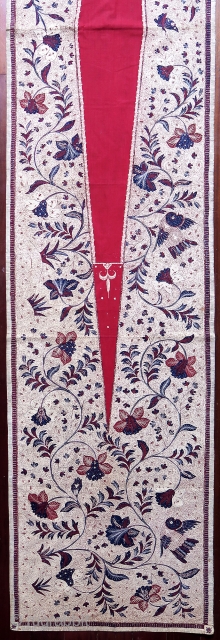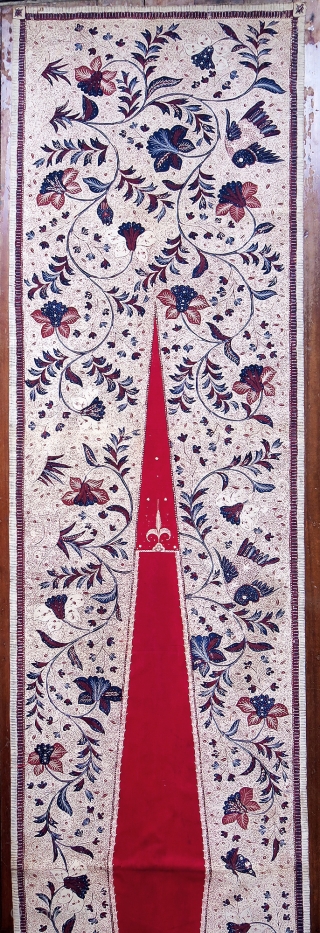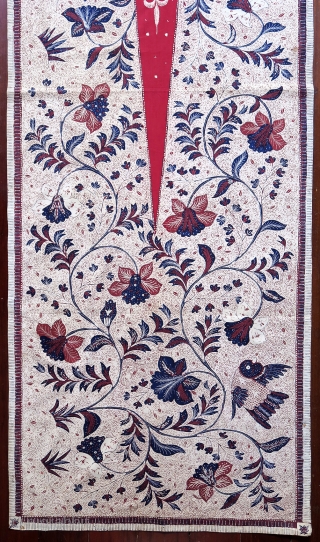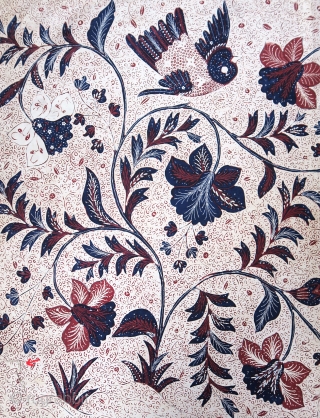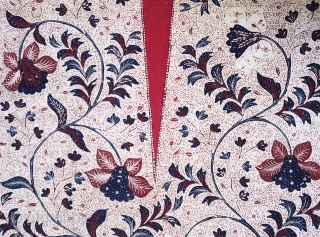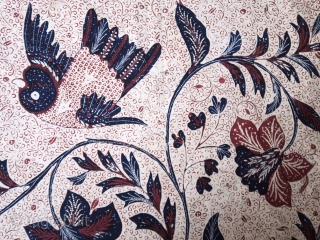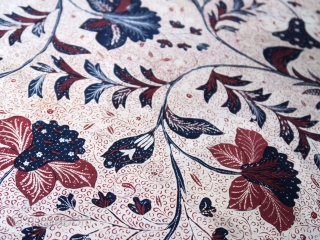Back
Java | Early 20th c Hand-Drawn Batik Breast Wrapper (Kemben)
Indonesia Java, Banyumas, 1920 – 1940
Commercial cotton, natural dyes, hand-drawn batik (tulis)
A graphic breast wrapper (kemben) hand-drawn with a distinctive batik pattern in the town of Banyumas in central Java. The striking ceremonial format contrasts the deep red elongated diamond reserved in the center with a surrounding batik design of natural motifs (a type of pattern called lung-lungan), in classic Banyumas colours of dark indigo and mangosteen red on a creamy white ground. a gracefully curved vine leads the eye through beautifully detailed flowers and leaf sprays, whose soft organic shapes and varied internal motifs (isen-isen) accentuate by contrast the bold geometry of the central diamond.
The piece displays the characteristic Banyumas combination of bold design with subtle detailing. Of special note is that one side only is decorated with four large birds drawn in a naïve, faintly humorous style. The birds are oriented so that they would appear along the uppermost edge, framing the wearer’s shoulders. This degree of asymmetry is unusual, showing the variation that is said to make hand-drawn batik alive. The single butterfly in the whole design is also placed along this edge, at the widest point of the diamond, so it would appear below the wearer’s face.
The points of the red diamond contain a crisp white flowering sprig growing from a mound. The internal border of a row of diagonally angled “flames” (cimukirran) is echoed in the outer border of dotted bars that enclose the design on all sides. These borders give the design a formal character, and were traditionally believed to protect the centerfield like a fence around a garden.
Context: This textile belongs to a very special and ancient type known as kain kembangan (flowered cloths), believed to be as old as the preparation and colouring of bark cloth. Kain kembangan have a large, undecorated geometric area in the center that makes an extremely forceful and dramatic effect by contrast with the regular, consistently repeating designs of the surrounding batik, which are calm in nature (Veldhuisen-Djajasoebrata, Weavings of Power and Might, 1988, 43-45).
Kain kembangan were worn as breast-cloths wrapped around the upper body by aristocratic or royal women of the court on ceremonial occasions. Large scale kembangan known as dodot were wrapped as an over-cloth around the hips by both men and women as a cloth of status. Kembangan were also used to cover festival food offerings and miniature ones were part of the sacred offerings and gifts in marriage, circumcision, and house-erecting rites.
The textile is in good condition, with a couple of flaws: it has a light stain (see image 8) and a careful indigenous repair at a corner (image 4). The colours are fresh, deep, and warm, and the cotton is of high quality, smooth, cool, and soft. This displays beautifully on a wall.
Length: 305 cm. Width: 52 cm.
Indonesia Java, Banyumas, 1920 – 1940
Commercial cotton, natural dyes, hand-drawn batik (tulis)
A graphic breast wrapper (kemben) hand-drawn with a distinctive batik pattern in the town of Banyumas in central Java. The striking ceremonial format contrasts the deep red elongated diamond reserved in the center with a surrounding batik design of natural motifs (a type of pattern called lung-lungan), in classic Banyumas colours of dark indigo and mangosteen red on a creamy white ground. a gracefully curved vine leads the eye through beautifully detailed flowers and leaf sprays, whose soft organic shapes and varied internal motifs (isen-isen) accentuate by contrast the bold geometry of the central diamond.
The piece displays the characteristic Banyumas combination of bold design with subtle detailing. Of special note is that one side only is decorated with four large birds drawn in a naïve, faintly humorous style. The birds are oriented so that they would appear along the uppermost edge, framing the wearer’s shoulders. This degree of asymmetry is unusual, showing the variation that is said to make hand-drawn batik alive. The single butterfly in the whole design is also placed along this edge, at the widest point of the diamond, so it would appear below the wearer’s face.
The points of the red diamond contain a crisp white flowering sprig growing from a mound. The internal border of a row of diagonally angled “flames” (cimukirran) is echoed in the outer border of dotted bars that enclose the design on all sides. These borders give the design a formal character, and were traditionally believed to protect the centerfield like a fence around a garden.
Context: This textile belongs to a very special and ancient type known as kain kembangan (flowered cloths), believed to be as old as the preparation and colouring of bark cloth. Kain kembangan have a large, undecorated geometric area in the center that makes an extremely forceful and dramatic effect by contrast with the regular, consistently repeating designs of the surrounding batik, which are calm in nature (Veldhuisen-Djajasoebrata, Weavings of Power and Might, 1988, 43-45).
Kain kembangan were worn as breast-cloths wrapped around the upper body by aristocratic or royal women of the court on ceremonial occasions. Large scale kembangan known as dodot were wrapped as an over-cloth around the hips by both men and women as a cloth of status. Kembangan were also used to cover festival food offerings and miniature ones were part of the sacred offerings and gifts in marriage, circumcision, and house-erecting rites.
The textile is in good condition, with a couple of flaws: it has a light stain (see image 8) and a careful indigenous repair at a corner (image 4). The colours are fresh, deep, and warm, and the cotton is of high quality, smooth, cool, and soft. This displays beautifully on a wall.
Length: 305 cm. Width: 52 cm.
price:
SOLD
- Home
- Antique Rugs by Region
- Category
- Profiles
- Post Items Free
- Albums
- Benaki Museum of Islamic Art
- Budapest: Ottoman Carpets
- Gulbenkian Museum
- Islamic Carpets. Brooklyn
- Islamic Textiles. Brooklyn
- Konya Museum: Rugs
- MKG, Hamburg
- MMA: Caucasian Carpets
- MMA: Mamluk Carpets
- MMA: Mughal Indian Carpets
- MMA: Ottoman Carpets
- MMA: Safavid Persian Carpets
- MMA: Turkmen Rugs
- McCoy Jones Kilims
- Ottoman textiles. Met
- Philadelphia Museum
- Rugs and Carpets: Berlin
- Seljuqs at the Met
- TIEM, Istanbul: Carpets
- V&A: Classical Carpets
- Vakiflar Carpets: Istanbul
- Baluch Rugs: Indianapolis
- Gallery Exhibitions
- Jaf an Exhibition
- Alberto Levi Gallery
- Andean Textile
- Christie's London: 2016
- Francesca Galloway
- HALI at 40
- ICOC Washington, DC 2018
- Jajims of the Shahsavan
- London Islamic Week April, 2018
- Mongolian Felts
- Navajo Rugs: JB Moore
- Persian Piled Weavings
- SF Tribal & Textile Art Show 2020
- SF Tribal 2019
- Sotheby's: C. Alexander
- Turkish Prayer Rugs
- Turkmen Main Carpets ICOC 2007







